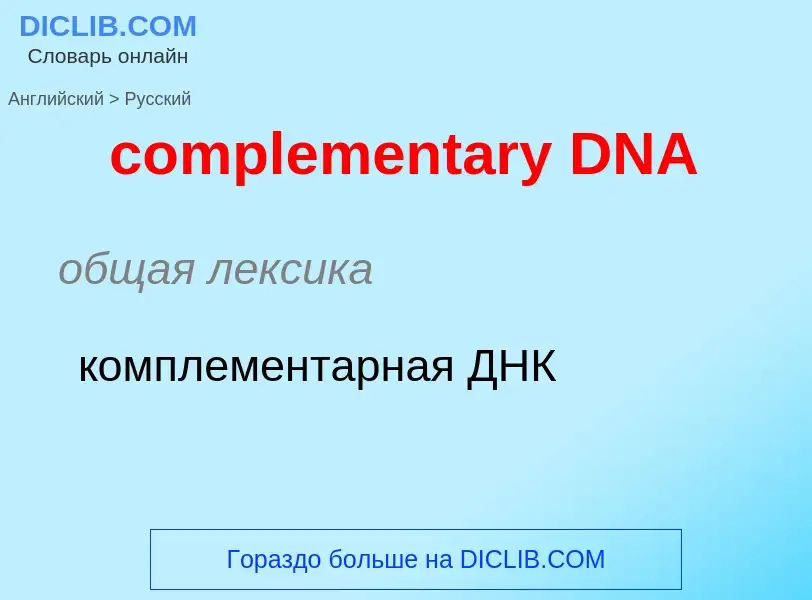Vertaling en analyse van woorden door kunstmatige intelligentie ChatGPT
Op deze pagina kunt u een gedetailleerde analyse krijgen van een woord of zin, geproduceerd met behulp van de beste kunstmatige intelligentietechnologie tot nu toe:
- hoe het woord wordt gebruikt
- gebruiksfrequentie
- het wordt vaker gebruikt in mondelinge of schriftelijke toespraken
- opties voor woordvertaling
- Gebruiksvoorbeelden (meerdere zinnen met vertaling)
- etymologie
complementary DNA - vertaling naar russisch
общая лексика
комплементарная ДНК
общая лексика
ДНК
дезоксирибонуклеиновая кислота
(Distributed Internet Application) распределённые приложения Интернет, архитектура DNA
(Digital Network Architecture) архитектура цифровой сети
сетевая архитектура, разработанная корпорацией Digital Equipment. Реализована в сети DECnet
синоним
Смотрите также
существительное
общая лексика
архитектура цифровых сетей
синоним
['s(j)u:pəkɔil]
общая лексика
суперспираль
спираль второго порядка
синоним
Definitie
Wikipedia

In genetics, complementary DNA (cDNA) is DNA synthesized from a single-stranded RNA (e.g., messenger RNA (mRNA) or microRNA (miRNA)) template in a reaction catalyzed by the enzyme reverse transcriptase. cDNA is often used to express a specific protein in a cell that does not normally express that protein (i.e., heterologous expression), or to sequence or quantify mRNA molecules using DNA based methods (qPCR, RNA-seq). cDNA that codes for a specific protein can be transferred to a recipient cell for expression, often bacterial or yeast expression systems. cDNA is also generated to analyze transcriptomic profiles in bulk tissue, single cells, or single nuclei in assays such as microarrays, qPCR, and RNA-seq.
cDNA is also produced naturally by retroviruses (such as HIV-1, HIV-2, simian immunodeficiency virus, etc.) and then integrated into the host's genome, where it creates a provirus.
The term cDNA is also used, typically in a bioinformatics context, to refer to an mRNA transcript's sequence, expressed as DNA bases (deoxy-GCAT) rather than RNA bases (GCAU).

![microarray]] used in testing microarray]] used in testing](https://commons.wikimedia.org/wiki/Special:FilePath/Cdnaarray.jpg?width=200)


![DNA major and minor grooves. The latter is a binding site for the [[Hoechst stain]] dye 33258. DNA major and minor grooves. The latter is a binding site for the [[Hoechst stain]] dye 33258.](https://commons.wikimedia.org/wiki/Special:FilePath/DNA-ligand-by-Abalone.png?width=200)
![animated version]]). animated version]]).](https://commons.wikimedia.org/wiki/Special:FilePath/DNA animation.gif?width=200)

![B]] and [[Z-DNA]] B]] and [[Z-DNA]]](https://commons.wikimedia.org/wiki/Special:FilePath/Dnaconformations.png?width=200)

.jpg?width=200)




![[[Maclyn McCarty]] (left) shakes hands with [[Francis Crick]] and [[James Watson]], co-originators of the double-helix model based on the X-ray diffraction data and insights of Rosalind Franklin and Raymond Gosling. [[Maclyn McCarty]] (left) shakes hands with [[Francis Crick]] and [[James Watson]], co-originators of the double-helix model based on the X-ray diffraction data and insights of Rosalind Franklin and Raymond Gosling.](https://commons.wikimedia.org/wiki/Special:FilePath/Maclyn McCarty with Francis Crick and James D Watson - 10.1371 journal.pbio.0030341.g001-O.jpg?width=200)
![Interaction of DNA (in orange) with [[histone]]s (in blue). These proteins' basic amino acids bind to the acidic phosphate groups on DNA. Interaction of DNA (in orange) with [[histone]]s (in blue). These proteins' basic amino acids bind to the acidic phosphate groups on DNA.](https://commons.wikimedia.org/wiki/Special:FilePath/Nucleosome1.png?width=200)




![The Eagle]] [[pub]] commemorating Crick and Watson The Eagle]] [[pub]] commemorating Crick and Watson](https://commons.wikimedia.org/wiki/Special:FilePath/TheEaglePub-Cambridge-BluePlaque.jpg?width=200)





